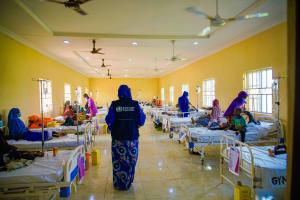Addressing heavy metal poisoning in Nigeria
Abuja ‒ It all began with a mild stomach ache, something seven-year-old Auwali Abubakar’s parents initially dismissed as a minor issue.
But as the days passed, the pain intensified and Auwali’s stomach began to swell. He experienced leg pain which affected his ability to walk, became lethargic and lost his appetite.
“I felt helpless as I watched my son suffer. Nobody knew what type of disease it was and no one could help him,” says his father Mallam Abubakar, from Zamfara State, in northwestern Nigeria.
This unknown illness has primarily affected children between 4 and 13 years, and some adults residing in two states in Nigeria. As of April 2024, there were 196 suspected cases and seven deaths reported in four localities in Sokoto State. Similar cases have also been reported in Zamfara State, prompting urgent action to identify the cause of the illness and implement measures to contain its spread.
Symptoms range from fever, abdominal swelling and pain, vomiting and significant weight loss, leaving medical practitioners uncertain of the nature or treatment of the condition. As a result, the Nigeria Centre for Disease Control and the affected state governments, in collaboration with World Health Organization (WHO), launched an investigation into the cause of the ailment and the line of treatment.
To support the investigation, WHO deployed a team of six epidemiologists to Zamfara and Sokoto states to work alongside local health officials. Their primary objective was to investigate the cause of the illness, contain its spread and provide medical care to those affected.
WHO supported the comprehensive response, harmonizing and strengthening surveillance activities for active case finding and training 77 clinicians at treatment centres on case identification and management, referrals, follow-up of health clients and risk communication and community engagement. The Organization also provided technical guidance and logistics for sample collection from affected people and the environment, laboratory testing and operations to reveal the causative agent of the disease.
After a thorough field investigation, findings from blood samples from affected people indicated a clear presence of heavy metal poisoning. While investigations are ongoing to rule out other associating factors, initial tests reveal elevated levels of lead, arsenic, mercury and cadmium in the blood of the affected people, possibly linked to industrial or mining activities and contaminated water and soil, among other sources.
“WHO has been a viable partner in the unravelling and treatment of cases in the state,” says Dr Yusuf Abubukar, Director of Public Health Service in Zamfara State. “The Organization has provided the state with technical, financial and logistics support during the investigation, surveillance and treatment of the patients.”
To trace unreported cases, WHO supported the states to improve case surveillance in neighbouring countries like Niger and Benin. WHO is working closely with the Nigerian government to share cross-border data and guidance, support surveillance, testing and clinical management and promote risk communication and community engagement.
“With a primary responsibility of saving lives and reducing suffering to the affected communities during emergencies, WHO is committed to continue supporting the Federal Ministry of Health and the two states through the Emergency Response and Preparedness team,” says Dr Walter Kazadi Mulombo, WHO Representative in Nigeria.
With Anwali recovered after receiving palliative care from a government hospital his father is relieved. “We are grateful for the intervention by the government and its partners like WHO that provided food and medication for the treatment of the children at no cost,” he says.
